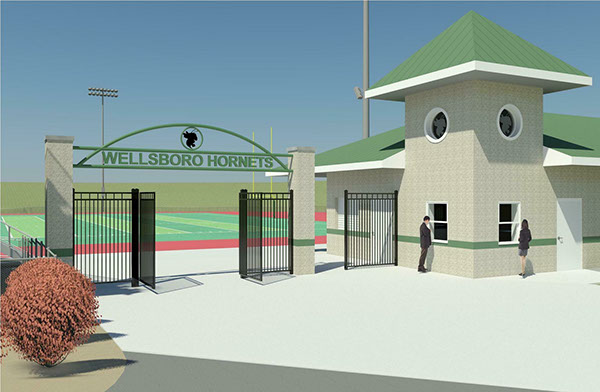Stadium Track Renovation In Time For Championships

Table of Contents
Planning Your Stadium Track Renovation
Before any work begins, meticulous planning is crucial for a successful and timely stadium track renovation. This stage sets the foundation for a smooth project. Failing to plan adequately can lead to significant delays and cost overruns, potentially jeopardizing your championship events.
-
Assess Current Condition: A thorough inspection by a qualified track expert is paramount. This assessment identifies the extent of damage, deterioration, and necessary repairs. Look for cracks, uneven surfaces, drainage problems, and wear and tear on the existing running surface. This detailed assessment informs the specifications for your renovation project. Consider using high-resolution photography and detailed reports to document the existing condition.
-
Set a Realistic Timeline: Championship dates are your hard deadline. Account for potential delays due to weather (especially crucial for outdoor tracks), material procurement lead times, and unforeseen issues like subsurface problems. Create a detailed Gantt chart or project schedule with milestones and deadlines for each phase, allowing for buffer time to manage risks.
-
Secure Necessary Permits and Approvals: Contact your local authorities early to understand the permitting process for stadium renovations. This often involves architectural and engineering reviews to ensure compliance with building codes and safety regulations. Delays in obtaining permits can severely impact your timeline, so proactive engagement is key.
-
Budget Allocation: Develop a comprehensive budget encompassing all aspects: materials (including surfacing, lane markings, and potentially subsurface work), labor costs, permits, contingency funds for unexpected issues (at least 10-15%), and potentially professional project management fees. A well-defined budget prevents cost overruns and ensures financial control.
Choosing the Right Materials and Contractors
The quality of materials directly impacts the longevity and performance of your renovated track. Selecting the right contractor ensures professional execution and adherence to specifications.
-
Material Selection: Research and choose high-quality, durable materials suitable for your climate and intended use. Consider factors like weather resistance, impact absorption, UV resistance, and compliance with relevant athletic standards (e.g., IAAF regulations for international competitions). Popular choices include polyurethane surfacing, synthetic running tracks (made from various materials like rubber or EPDM), and specialized lane markings designed for optimal visibility and grip.
-
Contractor Selection: Solicit bids from reputable contractors with proven experience in stadium track renovations. Check references, verify their liability and workers' compensation insurance coverage, and ensure their expertise aligns with your project's scope and complexity (e.g., experience with specific track surfaces). Thoroughly review contracts, including payment schedules and liability clauses, before signing.
-
Quality Control: Implement rigorous quality control measures throughout the renovation. Regular inspections by qualified personnel ensure standards are met and potential problems are caught early. Document each stage of the process with photos and reports to maintain a record for future maintenance and potential warranty claims.
Minimizing Disruption During the Renovation
Minimizing disruption to other stadium activities is vital, particularly when championships are imminent. A well-planned approach keeps the stadium functional while the renovation proceeds.
-
Phased Approach: If possible, break down the project into phases to limit impact. This might involve renovating sections of the track sequentially while allowing for partial usage. Careful planning of phases is critical to minimizing inconvenience.
-
Communication Plan: Establish clear communication channels with all stakeholders: athletes, coaches, event organizers, the public, and internal stadium staff. Keep everyone informed of the progress, any potential disruptions, and alternative arrangements (e.g., temporary training facilities).
-
Safety Precautions: Prioritize safety. Implement clear safety measures, including proper signage, barriers, designated walkways, and worker safety protocols to prevent accidents. Regular site safety inspections and adherence to all relevant safety regulations are non-negotiable.
Conclusion
Successfully completing a stadium track renovation in time for championships demands careful planning, meticulous execution, and a commitment to quality. By following these steps, you can ensure a smooth renovation process that delivers a high-performance track. This will enhance the athlete experience and uphold your stadium's reputation. Don't delay – start planning your stadium track renovation today to ensure your championships are held on a safe and world-class facility. Contact a specialist in stadium track renovation for expert advice and to get your project started.

Featured Posts
-
 Bayern Muenchens Bittere Afscheid Van Thomas Mueller Het Einde Van Een Tijdperk
May 11, 2025
Bayern Muenchens Bittere Afscheid Van Thomas Mueller Het Einde Van Een Tijdperk
May 11, 2025 -
 Who Will Be The Next Pope 9 Leading Candidates
May 11, 2025
Who Will Be The Next Pope 9 Leading Candidates
May 11, 2025 -
 A New Hope For Athletics The Grand Slam Track League
May 11, 2025
A New Hope For Athletics The Grand Slam Track League
May 11, 2025 -
 Fun Takes Flight At Flights Your Guide To Stress Free Travel
May 11, 2025
Fun Takes Flight At Flights Your Guide To Stress Free Travel
May 11, 2025 -
 Loanees Bid For Celtic Championship Glory
May 11, 2025
Loanees Bid For Celtic Championship Glory
May 11, 2025
